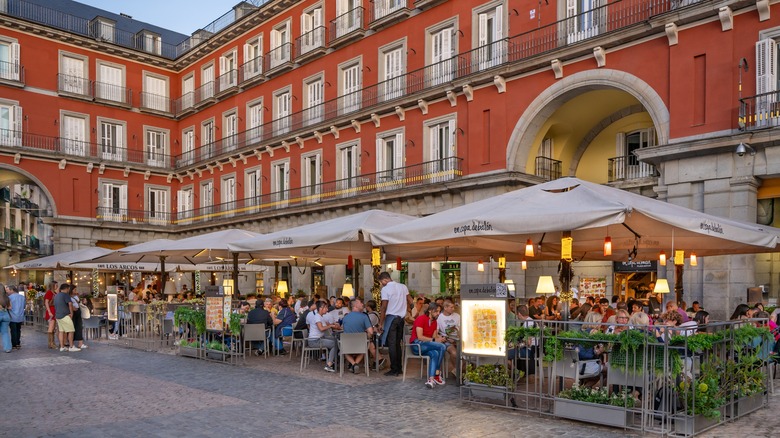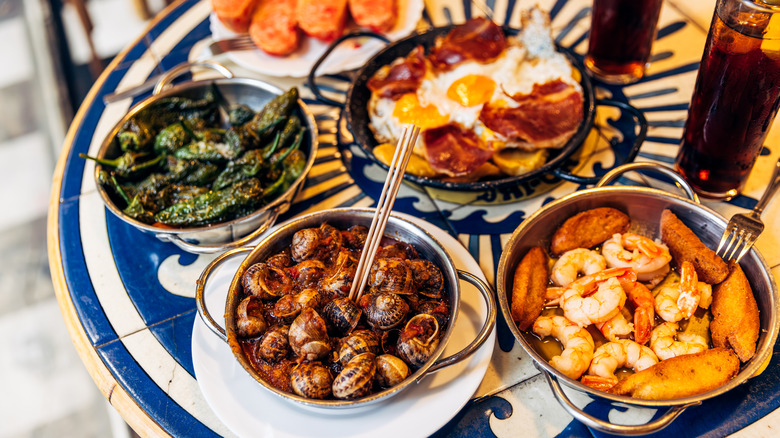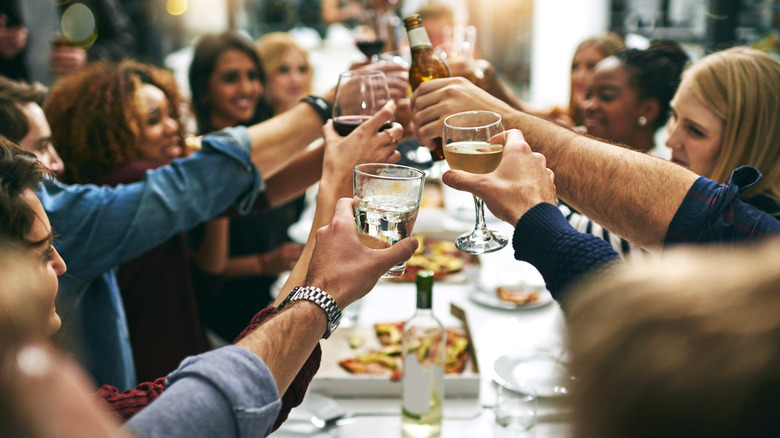If A Restaurant In Spain Is Getting Busy At These Times, It's Best To Avoid It Completely
Spain: the land of incredible culinary delights like tapas, pintxos, and paella. Each year, tourists flock to this beautiful country to taste paradise. Spain's dining options are endless if you want to try a new dish at a budget-friendly Michelin Star restaurant, enjoy a local favorite at a mom-and-pop place, or relax at a neighborhood cafe. With that said, there are some rules of thumb travelers should know before venturing to a new locale to enjoy a meal, and one of them may surprise you. Depending on the time of day, a busy restaurant might be a red flag, and signal that you are about to shell out your hard-earned cash on a tourist trap rather than a lovely meal.
If you're looking for an authentic dining experience in Spain, here's a valuable tip: Spaniards eat later than many other parts of the world. Meaning, if you pass a restaurant that is full at your regular dining hour of say, 5 p.m., you won't be dining with the locals. Some attribute Spain's late dining hours to their relaxed attitude, but the reality is much more interesting. In 1940, Spanish dictator, Francisco Franco, opted to shift the country's timezone forward by one hour to synchronize with Germany, another fascist regime at the time. Citizens then adapted accordingly, moving lunch and dinner an hour forward. The timezone was never changed back, so more than 80 years later, Spain's unique schedule necessitates travelers follow certain rules if they want to avoid dining at tourist traps.
Traditional meal times in Spain
There are a few red flags to avoid, such as avoiding restaurants with pictures of food out front, not dining somewhere if they serve paella every day of the week, and staying away from places with long menus offering everything from seafood to chicken fingers. But the most important thing to know to avoid tourist traps is when Spaniards sit down to dine. As mentioned above, Spain's mealtimes are later than you might be used to. If you're from the U.S., your stomach will probably start grumbling at what you would consider a normal hour, maybe 6 or 7 p.m.
A normal Spanish breakfast is typically just a piece of fruit or a pastry and a coffee, typically eaten around 7 a.m. Later in the morning, around 11 or so, a second breakfast is had. This meal is slightly more substantial, with a small sandwich or toasted bread with tomato puree on the menu. Called "almuerzo" or "la comida," which translates literally to "the meal," lunch is the most important meal of the day for Spaniards. The scent of Spanish delicacies wafts through the air as restaurants open their doors around 1:30 p.m., with family and friends trickling in around 2 p.m.
If you're looking for a real lunchtime steal, try finding a place offering a "menu del dia" (menu of the day), which is a fixed-price multi-course menu typically offered at a great price. Tapas and pintxo bars open their doors once the sun starts to set, and many people gather around outdoor tables to enjoy a quick snack or drink before heading off to dinner. Starting around 9 or 10 p.m., dinner is usually a lighter meal, however, restaurants offer everything from salad to a hearty plate of ox tail.
How to avoid tourist traps
So, knowing this, how can you make sure to avoid a major tourist trap? The number one rule to follow is to check what time a restaurant starts filling up. As mentioned above, lunch doesn't get going until around 1:30 or 2:00 p.m., and most authentic places won't be open before that time anyway. If you walk by a restaurant and see it filled up at noon, it's pretty much a guarantee that it is not a local hangout. The same goes for dinnertime, if the restaurant is busy around 6 or 7 p.m., keep on walking!
Of course, if you're hungry then you're hungry, but if you're seeking an authentic dining experience, you'll have to stifle your hunger until a later hour. Another thing to take note of is if there's a place you want to try, then make a reservation. If you wait until 2:00 p.m. for lunch or 8:00 p.m. for dinner to try to get into a restaurant, you'll most likely be out of luck as Spaniards love to sit and chat for hours with friends and family after finishing a meal, making seating limited.


